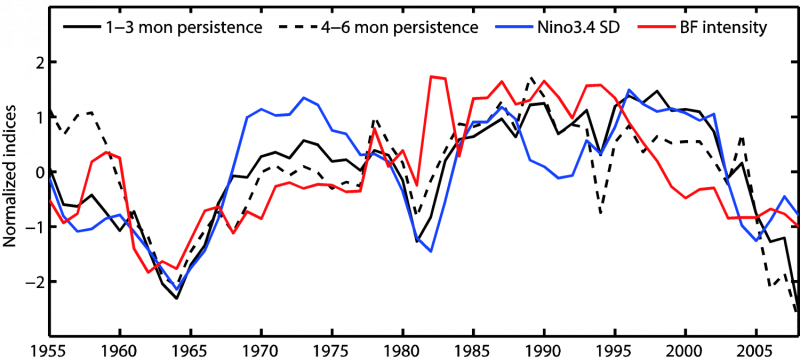Why has the El Nino-Southern Oscillation been more difficult to predict since 2000?

El Nino-Southern Oscillation (ENSO), a striking interannual variability in the tropical Pacific, has been extensively studied for several decades. Understanding the changes in its characteristics is still an important issue for worldwide environmental and socioeconomic interests. Clear decadal variations exist in the ENSO's predictability, with the most recent decade having the lowest ENSO predictability in the past six decades.
"The forecasting reliability during the period from 2002 to 2011 was relatively lower than that in the 1980s and 1990s." Observed Dr. Fei Zheng from Institute of Atmospheric Physics after he and his team examined the ENSO prediction skills of 20 state-of-the art models. They explored the possible reasons of modulating the decadal variations in ENSO's predictability, and recommended using the Bjerknes Feedback (BF) intensity, which dominates the development of ENSO, to determine ENSO predictability.
They found that decadal variations in BF intensity are largely a result of the sensitivity of the zonal winds to the zonal sea level pressure (SLP) gradient in the equatorial Pacific. Furthermore, the results show that during low-ENSO predictability decades, zonal wind anomalies over the equatorial Pacific are more linked to SLP variations in the off-equatorial Pacific, which can then transfer this information into surface temperature and precipitation fields through the BF, suggesting a weakening in the ocean-atmosphere coupling in the tropical Pacific.
For future research and forecasting practice, Zheng suggested, "More attention should be paid to off-equatorial processes in the prediction of ENSO during the low-ENSO predictability period."
Their findings were recently published in Geophysical Research Letters.
More information: Fei Zheng et al, Modulation of Bjerknes feedback on the decadal variations in ENSO predictability, Geophysical Research Letters (2016). DOI: 10.1002/2016GL071636
Journal information: Geophysical Research Letters
Provided by Chinese Academy of Sciences



















